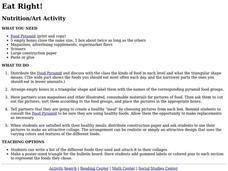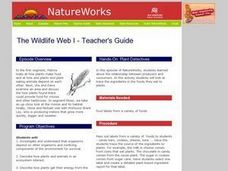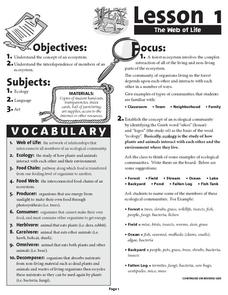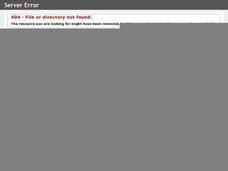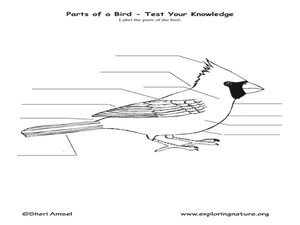Curated OER
House Bill No. 4097
Students identify healthy and unhealthy foods while considering a bill that would ban certain foods in schools. Through survey and discussion, they discuss a proposed legislative bill that would ban certain types of food in schools....
Curated OER
Eat Right!
Students use magazines and other food pictures to arrange healthy meals onto construction paper.
Curated OER
Indigenous People
Students examine what foods are indigenous to America and how Western European expansion impacted indigenous communities. They identify indigenous foods that they themselves eat, and label maps and identify ethnic groups in the Americas.
Curated OER
Dietary Fiber Introduction
Students identify fiber from foods, its sources and function in the body. They also the importance of fiber in the diet and good food sources that one can eat. Finally, students discuss water and its importance with eating fiber and...
Curated OER
Five a Day
Students look up and print definitions of fruit and vegatable. They write down their food intake for three days. They identify and categorize fruits and vegetables. They research how fruits and vegetables grow. They bring in their...
Curated OER
Harvest of Fear
Students research and debate the pros and cons of genetically altered foods. Students discuss whether they would be willing to eat genetically modified foods and whether these foods should be allowed to be created.
Curated OER
Media Collage
Pupils create "media Collages" out of labels from boxes, bottles, and cans, and other found objects in this Art lesson for all ages. Adaptations are included for younger and older students. Lesson also includes a writing option for...
Curated OER
Is Radio 1 British enough?
Students read the story Radio 1 defends not playing enough UK tunes. Students are then asked: What are the benefits of having a mix of musical cultures in a country?, Do countries lose a sense of identity when other cultures are added?...
Curated OER
Supermarket Science: The King Sooper Lab
Learners read product labels, compare fat, sodium, and sugar contents of various food items. They work with a partner and often employ the assistance of the deli and bakery managers in a supermarket.
Curated OER
The Wildlife Web I
Learners explore the relationship between producers and consumers. In this activity, they trace the ingredients in the foods they eat to plants. Supplement to Natureworks episode from New Hampshire Public Television, but activities may...
Curated OER
Wolf Habitat
Students identify their own basic needs for food, water, shelter and space in a suitable arrangement. They generalize that wolves and people have similar basic needs.
Curated OER
Eggs
Students know the following parts of an egg as the yolk, white, shell, membrane, chalaza, and air sac. They also sequence the growth of the chick in the egg. An egg is broken and students touch, smell and see it. They locate the six...
Curated OER
Get Nutty
Students research how nuts and seeds contribute to their overall good health.They recognize that nuts and seeds are a tasty addition to a meal. Students comprehend that nuts and seeds pose a risk for a small proportion of the population...
Curated OER
The Web of Life
Young scholars participate in a game in which they discover the balance of life in the ocean. They identify different organisms that rely on different types of food. They answer questions to complete the lesson.
Curated OER
Ocean Market
Students research how: The ocean is the source of many materials, from ores mined from its depths to relaxing mineral salts for a bath. Exquisite mother-of-pearl inlay, decorative shells, and pearl jewelry are found in gift shops...
Curated OER
CALORIE COUNTDOWN
Pupils will categorize foods according to their components and energy content.1. Design a large bulletin board with sections for carbohydrates, fats and proteins.
2. Ask students to bring labels and packages of different food products....
Curated OER
Texas Estuary Project
Students practice the proper lab techniques of coring, seining, taking temperatures, and salinity. Students analyze and graph data. Students write a 3 part essay and correctly draw and label a food web of their field site.
Curated OER
Hand washing Laboratory Activities
Middle schoolers are exposed to the benefits of many antimicrobial soaps to prevent infections. In the food-service industry, studies indicate that inadequate hand washing and cross-contamination is responsible
Curated OER
Yaba "Data" Cereal
Fifth graders create and modify a database using information from cereal labels.
Curated OER
Social Studies: Grab Day at the Pueblo
Pupils develop a cultural understanding of "Grab Day." Using magazines, they clip out pictures to make collages of items thrown down to people on this day. Students label the items in their collages.
Curated OER
Crab Lab
Learners participate in an activity in which they observe the behavior of a crab. In groups, they label and identify the function of each main part while observing and record their behavior. They make educated guesses on why they...
Curated OER
Chemical Reactions With Vinegar
Second graders observe chemical reactions. In this scientific inquiry lesson plan, 2nd graders determine whether vinegar creates a chemical reaction by observing two different experiments. A list of 7 supplies is included. In addition,...
Curated OER
Create a Habitat for an Animal
In this marine life learning exercise, students label the ocean animal and each part of its habitat. Students then draw one of the habitats including the animals and plants that live there.
Curated OER
Learning Bird Traits
Learners draw and label a bird. In this bird traits instructional activity, students learn what traits make a bird different from other animals. Learners are taught how to draw a bird and are expected to label the various body parts they...



